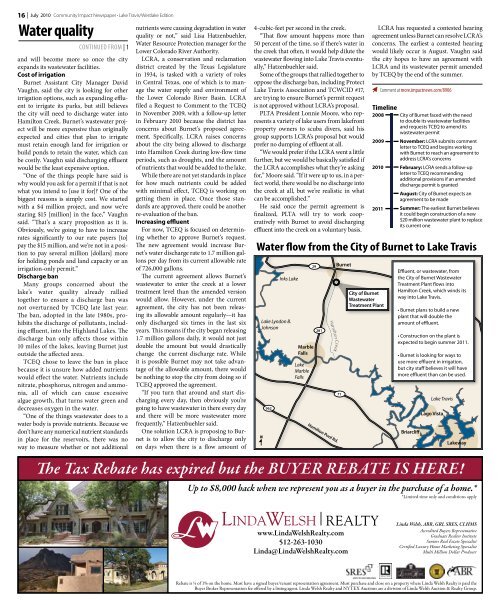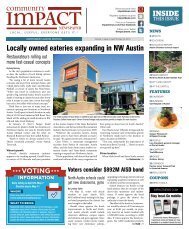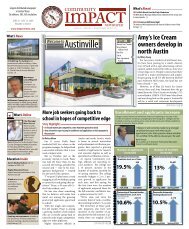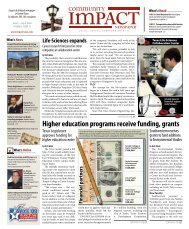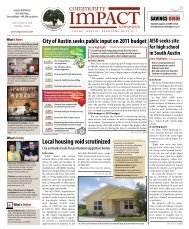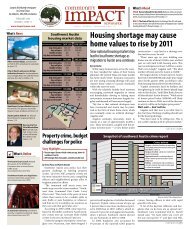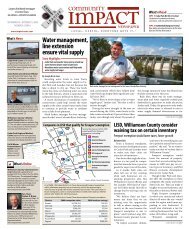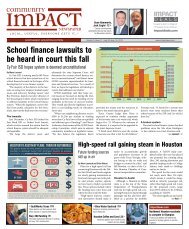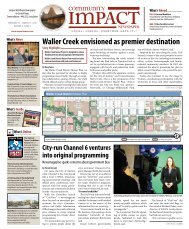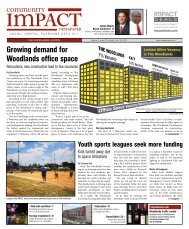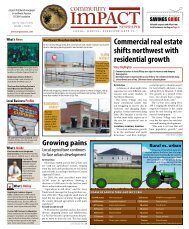July 2010 - Community Impact Newspaper
July 2010 - Community Impact Newspaper
July 2010 - Community Impact Newspaper
Create successful ePaper yourself
Turn your PDF publications into a flip-book with our unique Google optimized e-Paper software.
16 | <strong>July</strong> <strong>2010</strong> <strong>Community</strong> <strong>Impact</strong> <strong>Newspaper</strong> • Lake Travis/Westlake Edition<br />
Water quality<br />
CONTINUED FROM | 1<br />
and will become more so once the city<br />
expands its wastewater facilities.<br />
Cost of irrigation<br />
Burnet Assistant City Manager David<br />
Vaughn, said the city is looking for other<br />
irrigation options, such as expanding effluent<br />
to irrigate its parks, but still believes<br />
the city will need to discharge water into<br />
Hamilton Creek. Burnet’s wastewater project<br />
will be more expensive than originally<br />
expected and cities that plan to irrigate<br />
must retain enough land for irrigation or<br />
build ponds to retain the water, which can<br />
be costly. Vaughn said discharging effluent<br />
would be the least expensive option.<br />
“One of the things people have said is<br />
why would you ask for a permit if that is not<br />
what you intend to [use it for]? One of the<br />
biggest reasons is simply cost. We started<br />
with a $4 million project, and now we’re<br />
staring $15 [million] in the face,” Vaughn<br />
said. “That’s a scary proposition as it is.<br />
Obviously, we’re going to have to increase<br />
rates significantly to our rate payers [to]<br />
pay the $15 million, and we’re not in a position<br />
to pay several million [dollars] more<br />
for holding ponds and land capacity or an<br />
irrigation-only permit.”<br />
Discharge ban<br />
Many groups concerned about the<br />
lake’s water quality already rallied<br />
together to ensure a discharge ban was<br />
not overturned by TCEQ late last year.<br />
The ban, adopted in the late 1980s, prohibits<br />
the discharge of pollutants, including<br />
effluent, into the Highland Lakes. The<br />
discharge ban only affects those within<br />
10 miles of the lakes, leaving Burnet just<br />
outside the affected area.<br />
TCEQ chose to leave the ban in place<br />
because it is unsure how added nutrients<br />
would effect the water. Nutrients include<br />
nitrate, phosphorus, nitrogen and ammonia,<br />
all of which can cause excessive<br />
algae growth, that turns water green and<br />
decreases oxygen in the water.<br />
“One of the things wastewater does to a<br />
water body is provide nutrients. Because we<br />
don’t have any numerical nutrient standards<br />
in place for the reservoirs, there was no<br />
way to measure whether or not additional<br />
nutrients were causing degradation in water<br />
quality or not,” said Lisa Hatzenbuehler,<br />
Water Resource Protection manager for the<br />
Lower Colorado River Authority.<br />
LCRA, a conservation and reclamation<br />
district created by the Texas Legislature<br />
in 1934, is tasked with a variety of roles<br />
in Central Texas, one of which is to manage<br />
the water supply and environment of<br />
the Lower Colorado River Basin. LCRA<br />
filed a Request to Comment to the TCEQ<br />
in November 2009, with a follow-up letter<br />
in February <strong>2010</strong> because the district has<br />
concerns about Burnet’s proposed agreement.<br />
Specifically, LCRA raises concerns<br />
about the city being allowed to discharge<br />
into Hamilton Creek during low-flow time<br />
periods, such as droughts, and the amount<br />
of nutrients that would be added to the lake.<br />
While there are not yet standards in place<br />
for how much nutrients could be added<br />
with minimal effect, TCEQ is working on<br />
getting them in place. Once those standards<br />
are approved, there could be another<br />
re-evaluation of the ban.<br />
Increasing effluent<br />
For now, TCEQ is focused on determining<br />
whether to approve Burnet’s request.<br />
The new agreement would increase Burnet’s<br />
water discharge rate to 1.7 million gallons<br />
per day from its current allowable rate<br />
of 726,000 gallons.<br />
The current agreement allows Burnet’s<br />
wastewater to enter the creek at a lower<br />
treatment level than the amended version<br />
would allow. However, under the current<br />
agreement, the city has not been releasing<br />
its allowable amount regularly—it has<br />
only discharged six times in the last six<br />
years. This means if the city began releasing<br />
1.7 million gallons daily, it would not just<br />
double the amount but would drastically<br />
change the current discharge rate. While<br />
it is possible Burnet may not take advantage<br />
of the allowable amount, there would<br />
be nothing to stop the city from doing so if<br />
TCEQ approved the agreement.<br />
“If you turn that around and start discharging<br />
every day, then obviously you’re<br />
going to have wastewater in there every day<br />
and there will be more wastewater more<br />
frequently,” Hatzenbuehler said.<br />
One solution LCRA is proposing to Burnet<br />
is to allow the city to discharge only<br />
on days when there is a flow amount of<br />
4-cubic-feet per second in the creek.<br />
“That flow amount happens more than<br />
50 percent of the time, so if there’s water in<br />
the creek that often, it would help dilute the<br />
wastewater flowing into Lake Travis eventually,”<br />
Hatzenbuehler said.<br />
Some of the groups that rallied together to<br />
oppose the discharge ban, including Protect<br />
Lake Travis Association and TCWCID #17,<br />
are trying to ensure Burnet’s permit request<br />
is not approved without LCRA’s proposal.<br />
PLTA President Lonnie Moore, who represents<br />
a variety of lake users from lakefront<br />
property owners to scuba divers, said his<br />
group supports LCRA’s proposal but would<br />
prefer no dumping of effluent at all.<br />
“We would prefer if the LCRA went a little<br />
further, but we would be basically satisfied if<br />
the LCRA accomplishes what they’re asking<br />
for,” Moore said. “If it were up to us, in a perfect<br />
world, there would be no discharge into<br />
the creek at all, but we’re realistic in what<br />
can be accomplished.”<br />
He said once the permit agreement is<br />
finalized, PLTA will try to work cooperatively<br />
with Burnet to avoid discharging<br />
effluent into the creek on a voluntary basis.<br />
e Tax Rebate has expired but the BUYER REBATE IS HERE!<br />
Up to $8,000 back when we represent you as a buyer in the purchase of a home.*<br />
*Limited time only and conditions apply<br />
www.LindaWelshRealty.com<br />
512-263-1030<br />
Linda@LindaWelshRealty.com<br />
LCRA has requested a contested hearing<br />
agreement unless Burnet can resolve LCRA’s<br />
concerns. The earliest a contested hearing<br />
would likely occur is August. Vaughn said<br />
the city hopes to have an agreement with<br />
LCRA and its wastewater permit amended<br />
by TCEQ by the end of the summer.<br />
Timeline<br />
City of Burnet faced with the need<br />
to double its wastewater facilities<br />
and requests TCEQ to amend its<br />
wastewater permit<br />
November: LCRA submits comment<br />
letter to TCEQ and begins working<br />
with Burnet to reach an agreement to<br />
address LCRA’s concerns<br />
February: LCRA sends a follow-up<br />
letter to TCEQ recommending<br />
additional provisions if an amended<br />
discharge permit is granted<br />
August: City of Burnet expects an<br />
agreement to be made<br />
Summer: The earliest Burnet believes<br />
it could begin construction of a new<br />
$20 million wastewater plant to replace<br />
its current one<br />
Linda Welsh, ABR, GRI, SRES, CLHMS<br />
Accredited Buyers Representative<br />
Graduate Realtor Institute<br />
Seniors Real Estate Specialist<br />
Certi ed Luxury Home Marketing Specialist<br />
Multi Million Dollar Producer<br />
Rebate is ½ of 1% on the home. Must have a signed buyer/tenant representation agreement. Must purchase and close on a property where Linda Welsh Realty is paid the<br />
Buyer Broker Representation fee o ered by a listing agent. Linda Welsh Realty and NYTEX Auctions are a division of Linda Welsh Auction & Realty Group.<br />
2008<br />
2009<br />
<strong>2010</strong><br />
Water flow from the City of Burnet to Lake Travis<br />
Lake Lyndon B.<br />
Johnson<br />
N<br />
962<br />
Inks Lake<br />
Marble<br />
Falls<br />
Lake<br />
Marble<br />
Falls<br />
29<br />
281<br />
Hamilton Pool Rd.<br />
Burnet<br />
71<br />
2011<br />
City of Burnet<br />
Wastewater<br />
Treatment Plant<br />
Comment at more.impactnews.com/8906<br />
Effluent, or wastewater, from<br />
the City of Burnet Wastewater<br />
Treatment Plant flows into<br />
Hamilton Creek, which winds its<br />
way into Lake Travis.<br />
Briarcliff<br />
Lake Travis<br />
Lago Vista<br />
29<br />
• Burnet plans to build a new<br />
plant that will double the<br />
amount of effluent.<br />
• Construction on the plant is<br />
expected to begin summer 2011.<br />
• Burnet is looking for ways to<br />
use more effluent in irrigation,<br />
but city staff believes it will have<br />
more effluent than can be used.<br />
Lakeway


